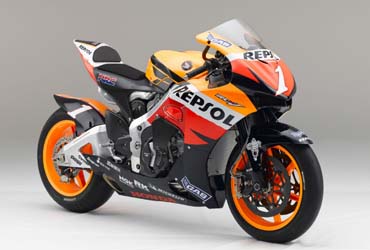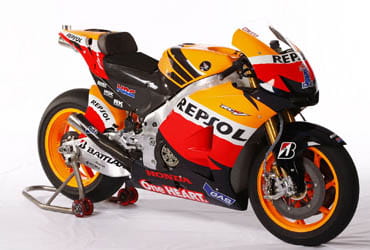Fifteen years ago we saw the biggest regulations shake-up ever witnessed in the top class of motorcycle racing. The introduction of the four-stroke MotoGP class, in one sweep, killed the two-stroke as a top-class racer and doubled the maximum permitted engine capacity.
The result was a class of monstrous machines that lives on today, albeit following much rule-tweaking. Massive power and torque unlike anything seen before in world championship road racing led to fearsome bikes that have made legends of the men who’ve tamed them.
Look back to the turn of the millennium and grand prix bike racing was in rut. The 500cc two-strokes might be evocative machines but they were irrelevant to the manufacturers that the series wanted to attract. Why invest a fortune in developing two-stroke technology, they wondered, when it was inherently unsuited to meeting the ever-more-demanding emissions limits that regulated road-going bikes? As marketing tools, the strokers didn’t reflect the competitors’ showroom machines and a lack of investment meant that the bikes weren’t evolving much from one year to the next.
Meanwhile, four-stroke superbike racing had flourished through the 1990s. Its road-based bikes looked familiar and inspired fanatical loyalty among fans, while charismatic riders in tooth-and-nail battles made it essential viewing. Grand Prix racing was under threat, struggling to attract both crowds and manufacturer involvement.
The solution was a technological upheaval. The creation of an open set of regulations that came into force in the transitory 2002 season, when satellite and private teams on strokers competed against the new four strokes, and took over completely in 2003.
All change for 2002
An unusual 990cc capacity limit for four-stroke engines was the headline shift. That seemingly arbitrary figure was picked to help ensure manufacturers didn’t simply pluck existing 1000cc (usually actually 998 or 999cc) engines from road bikes, and to help settle fears among world superbike bosses that the two championships would tread on each other’s toes.
The thinking was straightforward. In a two-stroke engine, each cylinder has a power stroke once per engine revolution. In a four-stroke it only happens once every two revolutions. So, in simple terms and at similar revs, a 500cc two-stroke will make as much power as a 1000cc four-stroke. MotoGP didn’t want to go backwards in terms of power, so rule makers aimed for as close to 1000cc as they could manage.
As well as the 990cc capacity limit, the rules specified that the engines had to be prototypes. You couldn’t just de-stroke a production motor to meet the capacity limit. One early competitor, the plucky WCM team that created its own four-stroke to compete against the factory efforts, fell foul of this when stewards decided its engine was too similar to that of a production Yamaha R1.
What the 2002 rule makers didn’t bank on was the level of expertise in making high-revving, high-performance four-strokes. While the rules were intended to favour the four-strokes, few expected them to be as powerful as they proved to be. Where the last of the 500s were reckoned to make around 180-200bhp, the 2002 four-strokes were immediately well over the 200bhp mark and development quickly pushed them higher still.
Within the new regulations were subtleties that initially led to widely differing concepts from one manufacturer to the next. Most importantly, the 990cc class hung onto the idea of offering different minimum weights depending on the number of cylinders used.
That’s because engines with more, smaller cylinders can generally rev higher than ones with fewer, larger pistons. More revs equals more power. Back in the 1960s, Honda proved to be the experts at this, creating machines like the famous 250cc six-cylinder and 125cc five-cylinder race bikes. Later, in the late '70s and early '80s, Honda’s NR500 – the last four-stroke GP racer before the 2002 class – tried to overcome rules limiting them to four cylinders by using oval pistons and eight valves per cylinder. It was basically a V8 with pistons merged into pairs, and while it still didn’t prove competitive against two-strokes, the design nearly matched them in terms of power.
The new rules for 2002, as a direct result of the NR500, specifically catered for oval pistons. Clearly believing Honda would revive the idea, the initial regulations added a 10kg weight penalty for oval-pistoned engines with less than six cylinders.
Two or three-cylinder bikes were allowed to be 135kg (145kg with oval pistons). Four or five cylinder machines had to be 10kg heavier at 145kg (155kg with oval pistons) while bikes using six cylinders – the maximum allowed under the 2002 regs – had to be 155kg (no additional penalty for oval pistons). This was an extension of previous GP regulations that limited four-cylinder strokers to 130kg and allowed twins like the Honda NSR500V and Aprilia’s 250-derived RSW to come in at a flyweight 105kg.
Surprisingly, manufacturers were fairly evenly split over their decisions in terms of cylinder count. Triples, fours and five-cylinders all raced in that first year, while both twin-cylinder and six-cylinder projects were also started, even if they never reached the track. In the run-up to the start of the series, speculation on the decisions that each firm would make ran rife.
Over the next few days we’ll be reintroducing you to every generation of each major MotoGP bike to have raced in the 15 years since MotoGP’s 2002 transformation and demonstrating how those bikes evolved into the masterpieces that will be battling for glory in 2017. Today we start by looking at the lineage of Honda's mighty RCV racer.
Gestation of the RC211V
In the run-up to 2002, everyone’s attention was focussed on Honda. The undisputed masters of GP racing, Honda already had key elements in place to be the dominating force in the new series.
Not only did the firm have the most recent experience of racing a four-stroke at GP level – the NR500 in the early 1980s – but it was also alone in having current F1 car technology at its disposal, having provided power to the BAR team (which it would later buy) since 2000. There was also the trifling matter of a young Italian chap by the name of Rossi who’d spectacularly sewn-up the last-ever two-stroke title on the firm’s old NSR500.
In the run-up to the RC211V’s reveal in early 2001 – nearly a year before it would race – Honda worked on a variety of engines. It ruled out twins and sixes – the former would be too weak, the latter’s power and heavier weight would destroy tyres too fast – but examined every other configuration before settling on a V5. It announced the bike’s layout in January 2001.
That layout surprised everyone. While many suspected that four-cylinder engine or inline triples would be the way to go in MotoGP, or possibly even V6s, the 75.5 degree V5 seemed an odd configuration.
While the layout, with three cylinders in the front bank and two in the rear, clearly throws up balance problems to be overcome, particularly at the stratospheric revs of a GP bike, Honda’s logic made sense. With five cylinders it could be nearly as powerful as a V6 while still using the same 145kg minimum weight limit as its more obvious four-cylinder rivals.
The RCV’s effect on production bikes
During the early years of the dominant V5-powered RC211V endless rumours circulated that Honda was developing a road going version. The truth of the issue is likely to remain hidden, but Honda certainly patented sketches of an RC211V with headlights and a licence plate, suggesting there was more than just wishful thinking behind the stories.
In terms of real production bikes, the Fireblade was the obvious beneficiary of the RCV’s development. The 2004 Blade (above) gained RC211V-shaped bodywork, leaning on the aerodynamic lessons from MotoGP, while the 2008 model adopted the compact, mass-centralised thinking of the RC212V.
Finally, of course, the RC213V led to the MotoGP bike for the road that had been on so many wish-lists for over a decade. Quite simply a full-on GP bike with the bare minimum of changes as a nod to legality and practicality, it doesn’t feature the works machines’ pneumatic valves or seamless shift, but is seriously close to the customer-spec RCV1000R racers.





























